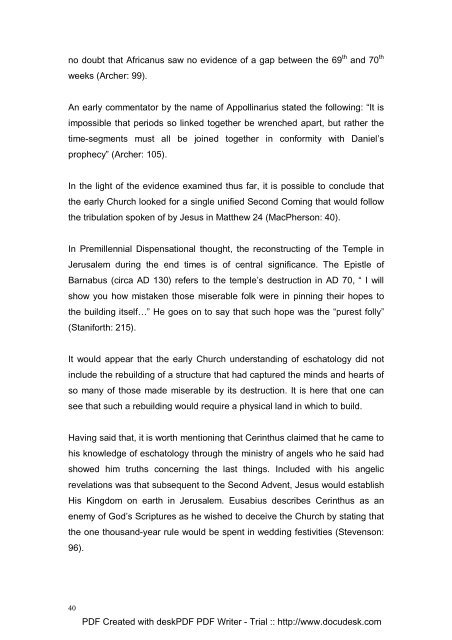A critical analysis of premillennial dispensationalism's interpretation ...
A critical analysis of premillennial dispensationalism's interpretation ...
A critical analysis of premillennial dispensationalism's interpretation ...
Create successful ePaper yourself
Turn your PDF publications into a flip-book with our unique Google optimized e-Paper software.
no doubt that Africanus saw no evidence <strong>of</strong> a gap between the 69 th and 70 th<br />
weeks (Archer: 99).<br />
An early commentator by the name <strong>of</strong> Appollinarius stated the following: “It is<br />
impossible that periods so linked together be wrenched apart, but rather the<br />
time-segments must all be joined together in conformity with Daniel’s<br />
prophecy” (Archer: 105).<br />
In the light <strong>of</strong> the evidence examined thus far, it is possible to conclude that<br />
the early Church looked for a single unified Second Coming that would follow<br />
the tribulation spoken <strong>of</strong> by Jesus in Matthew 24 (MacPherson: 40).<br />
In Premillennial Dispensational thought, the reconstructing <strong>of</strong> the Temple in<br />
Jerusalem during the end times is <strong>of</strong> central significance. The Epistle <strong>of</strong><br />
Barnabus (circa AD 130) refers to the temple’s destruction in AD 70, “ I will<br />
show you how mistaken those miserable folk were in pinning their hopes to<br />
the building itself…” He goes on to say that such hope was the “purest folly”<br />
(Staniforth: 215).<br />
It would appear that the early Church understanding <strong>of</strong> eschatology did not<br />
include the rebuilding <strong>of</strong> a structure that had captured the minds and hearts <strong>of</strong><br />
so many <strong>of</strong> those made miserable by its destruction. It is here that one can<br />
see that such a rebuilding would require a physical land in which to build.<br />
Having said that, it is worth mentioning that Cerinthus claimed that he came to<br />
his knowledge <strong>of</strong> eschatology through the ministry <strong>of</strong> angels who he said had<br />
showed him truths concerning the last things. Included with his angelic<br />
revelations was that subsequent to the Second Advent, Jesus would establish<br />
His Kingdom on earth in Jerusalem. Eusabius describes Cerinthus as an<br />
enemy <strong>of</strong> God’s Scriptures as he wished to deceive the Church by stating that<br />
the one thousand-year rule would be spent in wedding festivities (Stevenson:<br />
96).<br />
40<br />
PDF Created with deskPDF PDF Writer - Trial :: http://www.docudesk.com

















